Ultimate Cavapoochon Breed Guide: Are They Good Dogs? [with Photos]
Going home to your family is definitely one of the greatest feelings in the world. Add in an adorable Cavapoochon who also vies for your attention and all the day’s hard work is worth it.
A Cavapoochon? Yes. I know not everyone is familiar with this breed, but don’t you think it’s high time that you get to know one of the best dog breeds in the world?
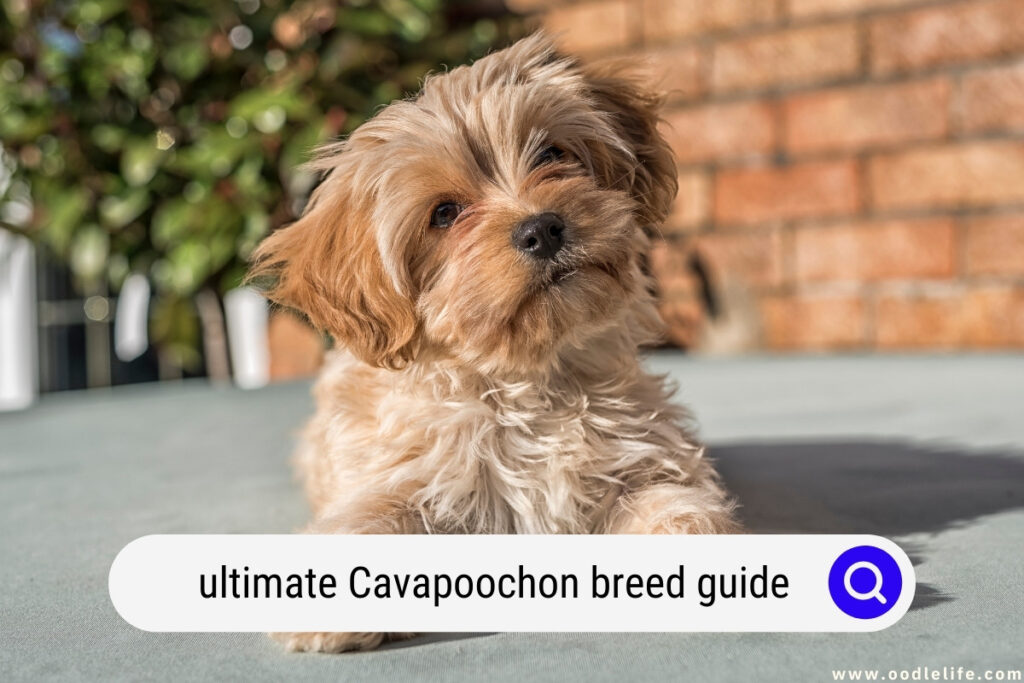
It sometimes pays, after all, to steer clear of the conventional Golden Retrievers, Shih Tzus, and German Shepherds.
Breed Overview
A Cavapoochon is a, first and foremost, a trihybrid, meaning their genes come from three different breeds—Cavalier King Charles Spaniel, Poodle, and Bichon Frise. And while they’ve recently gained popularity among tiny dog breeds, they’re still not quite as famous as their fellow designer breeds like the Goldendoodle or the Schnoodle.
A full-grown Cavapoochon’s size depends on their Poodle gene. Sadly, that’s also why the breed remains unrecognized (not considered a legitimate breed) by the canine world. Despite this caveat, though, Cavopoochons still fetch a considerable sum, sometimes reaching 2000 USD for a puppy.
While I can’t be sure why, I’m guessing their stuffed toy-like appearance and that they’re considered hypoallergenic may have a lot to do with it.
Cavapoochon Puppies
Like most small-breed dogs, Cavapoochon puppies are tiny, especially if they have Miniature or Toy Poodle blood. On average, they weigh between 9 and 12 pounds.
As puppies, Cavapoochons are always eager to eat and take naps. Don’t be surprised if you can’t tell their personalities at once. That may depend on their exact trihybrid combo.
Telling their fur color at this stage may not be doable, too. They may change color as they grow.
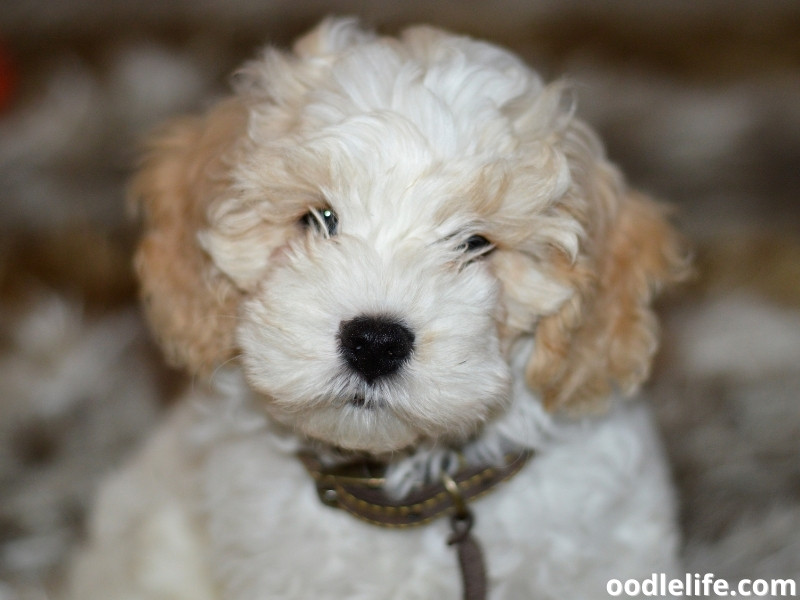
Adult Cavapoochons
Adult Cavapoochons won’t look much different from when they were young. They’re likely to put on much more weight than height, though. You see, adults with blood from tinier Poodle breeds can weigh between 12 and 15 pounds while those of bigger breeds can grow up to 18–20 pounds.
Their heights, however, only range between 9 and 14 inches. Note, too, that males can be slightly bigger than females.
They reach adulthood after a year. By then, their fur color would remain the same throughout life. Cavapoochon fur colors include:
- Apricot
- Black
- Black, tan, and white
- Black and tan
- Blenheim
- Cream
- Red
- Sable
Adult Cavapoochons live between 12 and 15 years, depending on how healthy they are, of course, and exhibit these traits and characteristics:
- Curly hair from head to paws, likely longer around the eyes.
- A round face with eyes peeking out of their fur, making them look like teddy bears.
- Almond-shaped, expressive eyes.
- Floppy ears with longish hair on both sides.
- A stocky build.
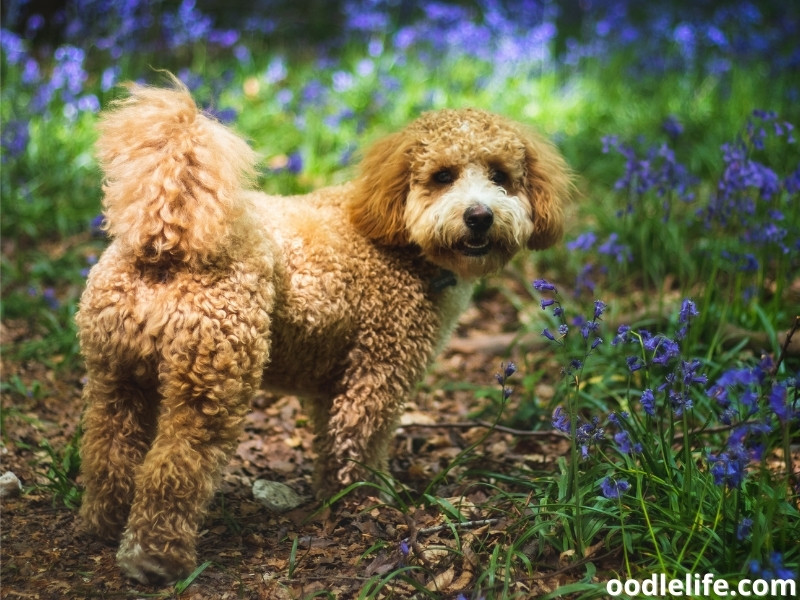
Brief History
We can thank two dog enthusiasts for the Cavapoochon’s creation—Steve and Linda Rogers. Together with veterinarians and other reproductive specialists, the first fruit of their labor was born in 2001 in Arizona.
To go about the breed’s creation, they first had to breed the Cavapoo (a Cavalier King Charles Spaniel and Poodle combo), then the Cockapoo (a Cocker Spaniel and Poodle combo), and the Cavachon (a Cavalier King Spaniel and Bichon Frise combo). Mixing all those mixed breeds were necessary to come up with the end result—the Cavapoochon.
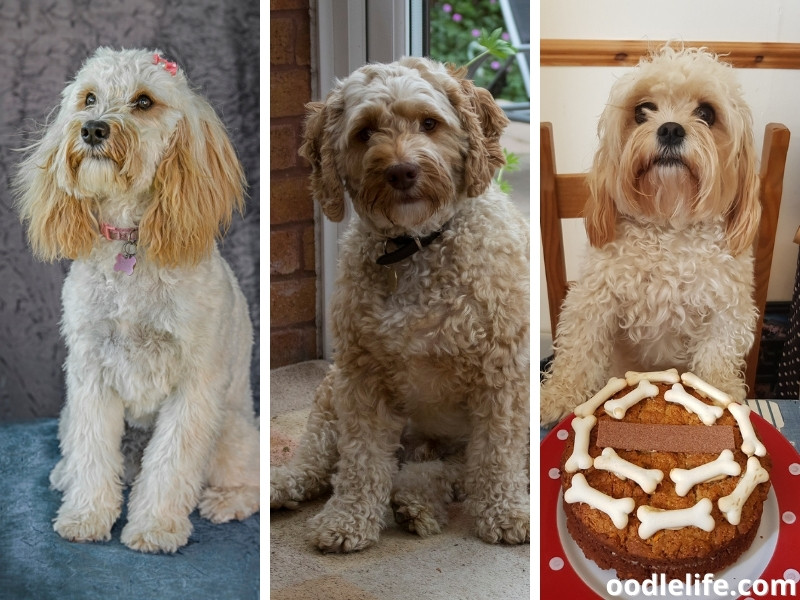
Cavapoochon Personality
Temperament
Cavapoochons are highly sociable, fun, confident, empathetic, and sweet-natured, making them perfect for human companionship. They are even easy to manage in a household with kids because they can quickly bond with their owners. This trait, however, makes it hard to leave them alone at home because they can be prone to separation anxiety.
If you need to travel for prolonged periods, it may be best to leave them in a dog sitter’s care or, in my case, in another dog’s company. It also works to keep them occupied when I work long hours.
Apart from their mild temperament, Cavapoochons like my Mox, are not that loud. In fact, his barks will never wake anyone up in the middle of the night, not even me.
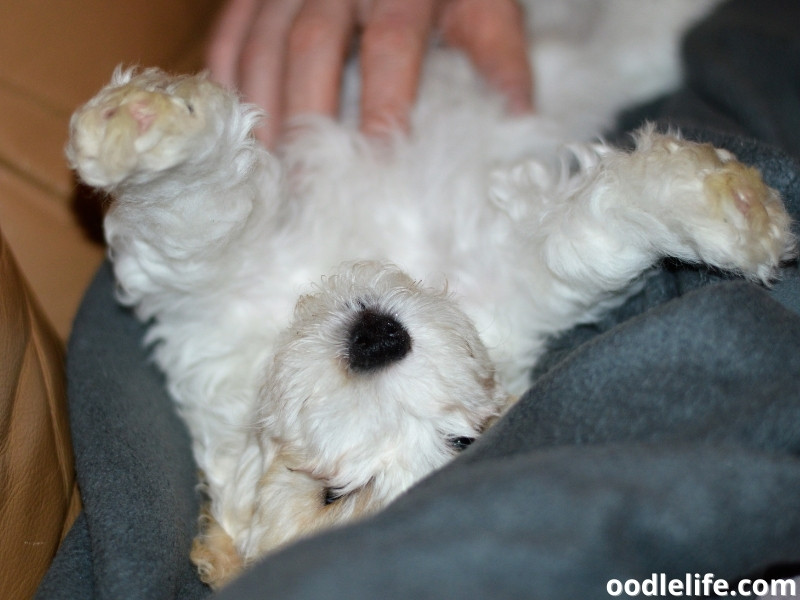
Interaction
With Strangers
Cavapoochons are very friendly, even to strangers. And boy do they love getting attention. Despite their typical social nature, though, you need to be careful not to leave them alone with just strangers in public places.
As we said earlier, they are prone to suffering from separation anxiety, thanks to their Bichon Frise bloodline.
With Kids
Cavapoochons are great with kids not just because they’re small but also because of their mild temperament. Thanks to the Poodle bloodline, they’ll always know if your children need comforting. Their Bichon Frise nature, meanwhile, won’t make them fussy if your kids want to play, whether inside or outdoors.
With Fellow Dogs and Other Animals
Owners can argue that their Cavapoochons are the friendliest dogs ever. They not only do well in the midst of people but also fellow dogs and other animals (yes, even cats). Just be careful if they take more after the Cavalier King Charles Spaniel forebears, as that particular breed loves chasing smaller animals like cats or rodents.
Cavapoochon Care Requirements
Feeding
Like any other pet, Cavapoochons would stay healthy and live to their fullest if you feed them a high-quality and balanced diet. You can choose from four types of readily available dog food in most groceries—kibble, canned or wet food, semi-moist, and frozen.
It all depends on how old they are. It’s best to feed puppies small dry meals 2–3 times a day. Adults need 3–4 square meals a day.
Your choice in adult dog food also depends on how much time you have to prepare your pet’s meals and which kind they like most. Trying each type at least once to get your pet’s reaction won’t hurt. Choose brands that are calorie-dense, especially those specially made for smaller breeds.
Your lifestyle may also affect what you’ll end up feeding your dog. If they eat indoors, it may be best to stick to dry food (less spillage that way). Given their generally small size, Cavapoochons may do better with bite-sized food so there’s no danger of them choking.
Exercise
As a breed that’s not known for being active, Cavapoochons don’t require much physical exercise. They do need mental exercise, though.
Short walks (about half an hour long should do) and some playtime at home are enough to keep your puppies healthy and fit. Adults may need a while longer, depending on how big they end up becoming.
Cavapoochons’ boredom mostly stems from lack of mental stimulation. They are, after all, very intelligent. To keep them occupied, you can let them explore their surroundings during walks, perform simple tricks, do agility exercises, or play with puzzles or treat-dispensing toys.
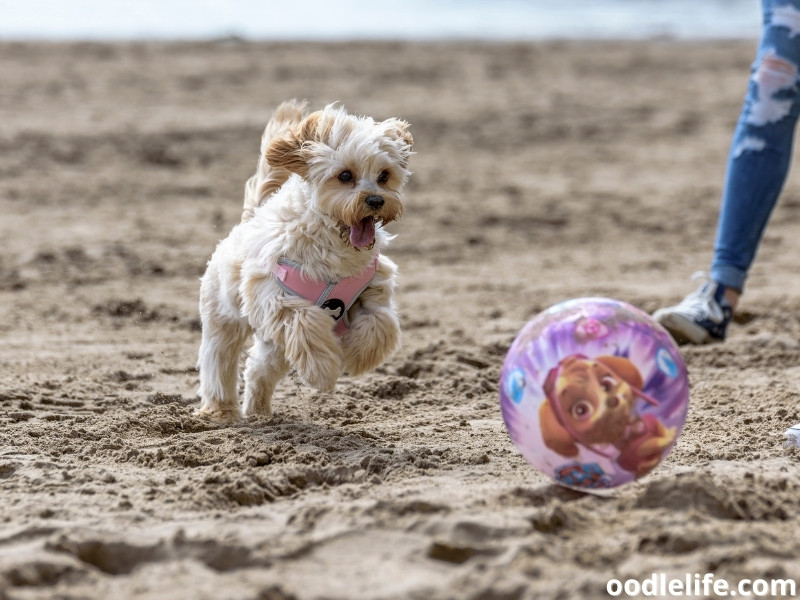
Training
Given their intelligence (thanks to their Poodle forebears), Cavapoochons are easy to train. They learn best, though, through positive reinforcement, especially since they always aim to please. As such, they would do very well if they get treats each time they perform a task correctly.
Do training exercises regularly but try as much as possible to keep calm all the time. My Mox, for instance, doesn’t respond too well to a stern demeanor. Establishing a training schedule and routine every day works.
Fifteen minutes daily can do wonders in developing their habits.
To practice their socialization skills, train them to play with other dogs if you take them to parks or other shared spaces in your community. That’s a great way to lessen their anxiety.
Grooming
Curly hair is always harder to manage than clipped or straight hair, we all know that for people. The same is true for dogs. As such, you need to brush your Cavapoochon’s fur every two days to remove tangles and dirt.
Experts recommend using a slicker brush to remove matting (it’s self-cleaning, too). Using an anti-tangle spray would do wonders as well.
On the plus side, despite their curls, Cavapoochons generally don’t shed that much. But their fur does need more regular grooming.
Bathe them once a week, especially if they often go outside to play. Organic shampoos are highly recommended. Also don’t just brush their fur afterward.
Do that before bathing, too, to make postbath fur brushing easier.
Brush their teeth every three days. You don’t want them to get severe gum diseases, right? Avoid using toothpastes with chemicals and preservatives.
Health Care
While Cavapoochons did inherit their forebears’ good traits, that also meant being prone to the same illnesses their ancestors are, such as:
- Ear infections, mostly due to their furry ears. To avoid these, clean their ears regularly, making sure they’re dirt- and earwax-free. Use a cotton pad with an ear cleaning solution for that.
- Eye diseases like dry eye syndrome with age. If left untreated, it can lead to more severe infections. Check your dog’s eyes for signs of redness, discharges, and swelling. You can prevent the illnesses by wiping your pet’s eyes once a day with a clean towel dampened with warm water. If symptoms persist, take your Cavapoochon to the vet.
- Heart problems, specifically Patent Ductus Arteriosus, which carries blood to the lungs, leading to fluid buildup, is common among Cavapoochons. Fortunately, dogs only develop this in old age, but to be sure, subject your pet to regular heart checkups. Caught early, the disease is treatable with maintenance meds.
- Seizures that may lead to epilepsy, common among dogs with Toy Poodle genes, also affect some Cavapoochons. If your pet suffers from seizures, bring him to a vet at once. Meds can alleviate them.
- Loose knees caused by illnesses like Patella Luxation can also affect Cavapoochons. This causes your dog’s knee cap to get temporarily dislocated, causing him to limp. Consult a vet immediately if you don’t want your pet’s affected leg to stay that way.
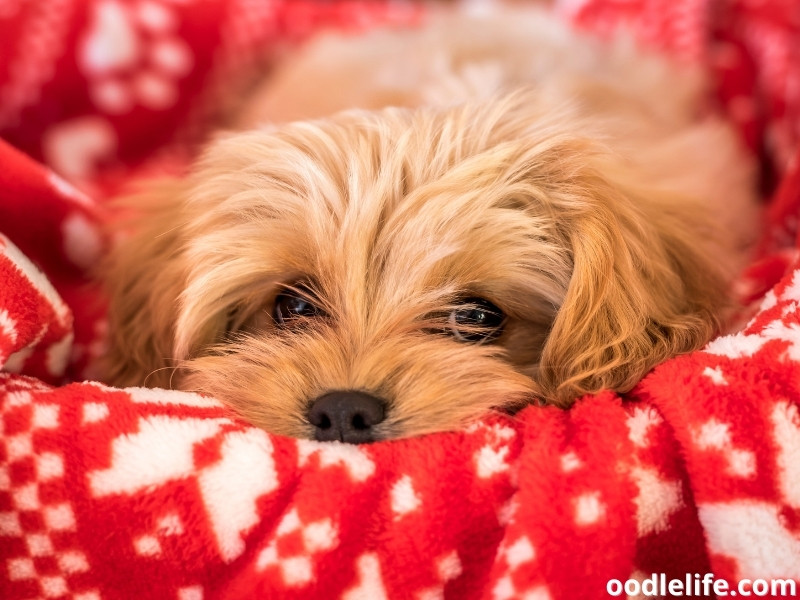
Positives and Negatives
You may be considering getting a Cavapoochon as your next best friend, it is, after all, one of the rarest designer dog breeds to date. They are also adorable and super friendly, perfect companions even if you have kids or frequent visitors.
If you’re concerned about their full-grown size due to building regulations, perhaps, ask their breeders what exact Poodle breed genes they’re endowed with. If they come from a line of Miniature or Toy Poodles, you’re in the clear.
Like any other dog breeds, owning a Cavapoochon comes with specific care instructions. We’ve outlined most of them for you. Let’s look back on the pros and cons discussed earlier.
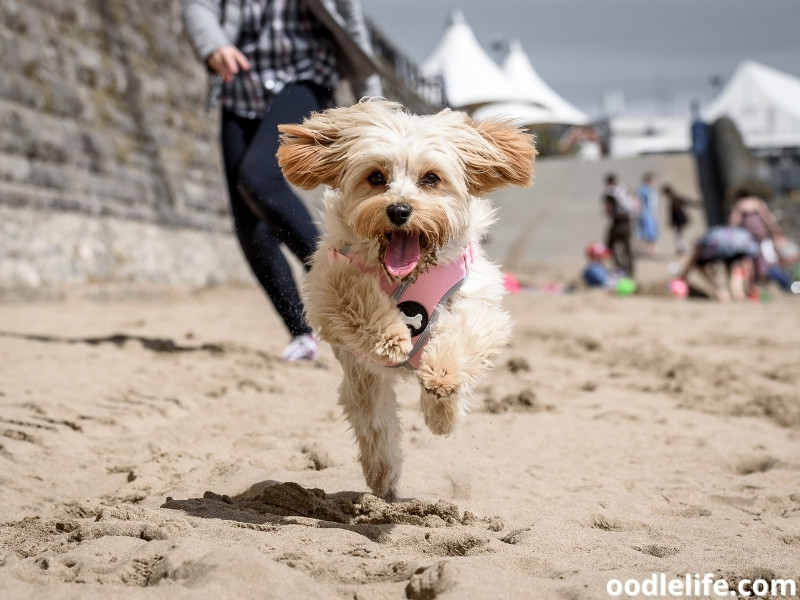
Pros
- Minimal physical exercise required, perfect for owners with long work hours
- Ideal for people with allergies, as they don’t shed fur.
- Suitable for small house or city apartment living due to their compact size, social nature, and light barking.
- Highly intelligent, making them easy to train.
Cons
- Almost impossible to adopt or rescue since the breed is very rare.
- Come with a high price tag.
- Prone to suffering from separation anxiety.
- Hybrid nature makes them prone to all the illnesses that affect their three gene contributors—Cavalier King Charles Spaniel, Poodle, and Bichon Frise.
- Need regular grooming, including bathing and fur and teeth brushing.
Final Thoughts
I hope you now have everything you need to make that final decision—if a Cavapoochon is your perfect companion.
If you’re not the most physically active person in the world, a Cavapoochon is the breed for you. Much like you, perhaps, it enjoys the quiet life, perfectly content lounging around the house—solving puzzles, playing with toys, or just napping. As an added bonus, it doesn’t bark much, which allows you to focus on your work or spend some me time (watch a movie, perhaps).
If you’re more of the social type, a Cavapoochon is a great choice, too. It’s very sociable so taking your pet out for a walk around the neighborhood won’t be a problem. It’ll even feel at home if you’ve got people around. It’ll even love the extra attention.
Isn’t a Cavapoochon a rare gem?